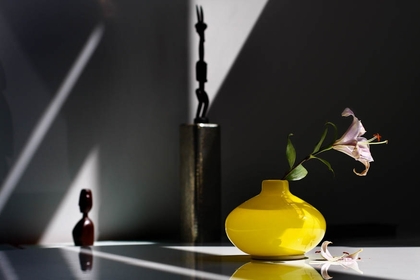

Still life and the alchemy of art
My wife and I did things differently this Christmas. We had some friends over for a Vigilia supper on Christmas Eve. That means a meatless meal, in this case a large mixed salad with a mustard mayonnaise dressing, Sonny D’Angelo’s wondrous seven-fish sausages, mushroom caps stuffed with crabmeat, lots of shrimp, and some brie de meaux from DiBruno’s. That’s the advantage of living a few feet away from the Italian Market.
Anyway, that was Christmas Eve. On Christmas Day, having no one visiting and visiting no one ourselves, Debbie and I went Jewish: We joined out friends Kass and Eric Mencher for Chinese food at Mustard Greens.
Eric and I worked together in Dublin in 2004 on a feature about the 100th anniversary of Bloomsday (the idea was Eric’s; I got to go along because I was The Philadelphia Inquirer’s book editor at the time).
Eric is a great photographer, not just a very good one. We have one of his photos hanging in our living room, and most people, when they first see it, think it’s a painting. It is a shot of people crossing the O’Connell Street Bridge during rush hour, and there is a peculiar medieval quality to the composition and tone.
Anyway, before we took off for dinner, Eric showed us some photos he had just taken. One in particular fascinated me. Here it is.

Aside from its obvious beauty, what really intrigues me about this picture is where it was taken: In the living room of the Menchers’ apartment, just a few feet from where I was standing. I would never have guessed.
When Eric told me that, I turned and looked, and could see where the vase and the other objects had been placed. But the setting was altogether different from the picture. The living room is a perfectly nice and neat space, and I had just been sitting there, but when I looked at it again there was absolutely nothing about it that would have brought to mind that photo.
Such is the alchemy of art.
In the visual arts, of course, whether representational or not, the handling of abstract elements is crucial. Often, the objects themselves — in, say, a Chardin painting of some fruit, a bowl, and a goblet — may be of little inherent interest. It the arrangement and the light that create the interest, prompting us to see these ordinary, everyday things in such a way as to no longer take them for granted.
The objects in Eric’s photo — the vase itself, the lily, the African figurines — happen to be interesting in themselves, but the power of the photo derives, I think, from the manner in which the light has been turned into a hard-edge abstraction. It is a fine example of how art, however representational, never simply transcribes what is “out there,” but selects certain details and arranges them into a harmony that transfigures them.
Robert Musil said that “all still lifes are actually paintings of the world on the sixth day of creation, when God and the world were alone together, without man!” This is precisely right, as I think Eric’s photo demonstrates it. Still lifes have a quieting effect on us. They do not merely invite us to contemplate; they actually switch off, however briefly, the interior chatterbox. “So it must have been after the birth of the simple light / In the first, spinning place,” wrote Dylan Thomas.
Art can cast the world in a critical light, but at its best — as in this photo — what it does is grant us a glimpse of the world’s original innocence.
Latest posts by Frank Wilson (Posts)
- An illusion of precision - September 9, 2015
- Watching the passing scene - October 28, 2013
- To see like a child - June 26, 2013
- Riffing and digressions - January 21, 2013
- Life is a parenthesis between one darkness and another - September 13, 2012
 Print This Post
Print This Post




I’ve been thinking for a couple of years about what I’ve been calling abstract realism in photography—that is, abstraction as discovered in photography, which is an image of the “real” without interference. What you’re saying here dovetails nicely. You’re absolutely correct about the arrangement of light and shadow making abstract forms come alive in the photo.
The sixth day of creation is also some thing I deal with all the time as a photographer. When I’m out on a roadtrip, making photographs and video of natural scenes, such as the mountains or ocean, or the National Parks, I am conscious of wanting to capture the feel of the sixth day of creation. Of course that’s nothing new in modern landscape photography. One could say a great deal about Ansel Adams’ work from this perspective, for example.
The texture of that vase is fascinating — almost looks like it’s painted on canvas.
I personally take photos of the interiors, it is always the greatest joy to capture the position of light, slowly making its way all over the objects in the room and when these are arranged right, you said it very nicely it turns into hard-edge abstraction. There can be some fascinating pictures when you shoot in the room with some translucent objects.
Musil is wrong. Without man’s imagination, a still life would be impossible.
I don’t think Musil was factoring out human imagination, but he was thinking of imagination not in terms of its inventiveness — which is overrated anyway — but in terms of its powers of discernment, in this case the power to discern the world with man factored out.
Wonderful analysis, Frank — and an extraordinarily worthy photographer to use as reference.